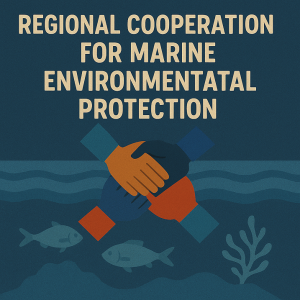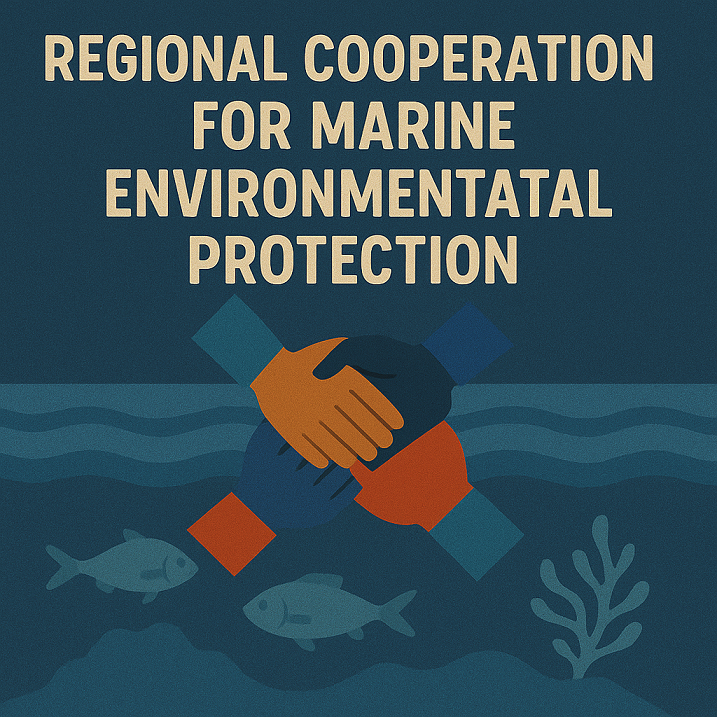Is regional cooperation for marine environmental protection working—or is it just rhetoric? Explore real-world frameworks, data-backed challenges, and solutions in this deep dive into maritime sustainability.

Why Regional Cooperation Matters in Today’s Maritime Environmental Landscape
Oceans know no borders. Yet, marine pollution, overfishing, biodiversity loss, and climate impacts are often treated as national or local problems. Regional cooperation for marine environmental protection has long been touted as the solution to transboundary marine challenges. But is it truly working? Or is it just rhetoric wrapped in diplomatic promises?
From the South China Sea to the Baltic, nations have signed dozens of regional treaties, memorandums, and action plans. These agreements are designed to coordinate responses across sectors and borders. But beneath the surface, cooperation remains uneven.
As maritime professionals, students, and stakeholders in global ocean governance, it’s time we ask: Are these frameworks making a real impact, or merely buying time through talk?
The Case for Regional Marine Cooperation
Regional cooperation is essential because many marine threats cross Exclusive Economic Zones (EEZs). Oil spills, microplastic drift, fish migration, and ballast water discharges don’t stop at borderlines. Effective coordination can:
- Pool resources for pollution monitoring
- Harmonize maritime environmental regulations
- Enable joint emergency responses
- Strengthen enforcement against illegal fishing
Organizations such as the Regional Seas Programme (UNEP), the Partnerships in Environmental Management for the Seas of East Asia (PEMSEA), and the Barcelona Convention for the Mediterranean offer frameworks for collaborative ocean management.
In theory, regional action is a bridge between global policies like the MARPOL Convention, and local realities. In practice, the results are mixed.
–
Regional Seas: A Review of Performance
Successful Examples: The Baltic Sea and the Mediterranean
Baltic Sea (HELCOM)
The Helsinki Commission (HELCOM) is often cited as a model. All bordering countries participate, including EU and non-EU members like Russia. Its Baltic Sea Action Plan has reduced oil spills, improved nutrient monitoring, and implemented regional bans on sewage discharge from passenger ships.
A 2022 report by the European Commission confirmed measurable declines in eutrophication levels and organic pollution across the region.
Mediterranean Sea (Barcelona Convention)
The Barcelona Convention, first signed in 1976 and revised in 1995, covers 22 coastal nations and the EU. Despite political fragmentation, it has introduced:
- A regional oil pollution contingency plan
- A legally binding protocol on integrated coastal zone management (ICZM)
- Regional Marine Pollution Emergency Response Centre (REMPEC) in Malta
This framework enables coordinated ship inspection, satellite surveillance, and uniform reporting of pollution events.
Less Effective Examples: South China Sea, West Africa
South China Sea
Despite multiple overlapping claims, countries have made gestures toward cooperation. PEMSEA has developed coastal strategies in Vietnam, the Philippines, and China. But environmental protection remains entangled in geopolitical tensions.
A 2023 study by the World Ocean Review found that joint projects like marine protected areas (MPAs) or shared fisheries data platforms are still rare.
Gulf of Guinea
The Abidjan Convention for West Africa aims to foster marine conservation. However, limited funding, piracy concerns, and weak enforcement mechanisms have undermined progress.
Reports from IMO, UNCTAD, and Marine Pollution Bulletin confirm that IUU fishing and oil spills continue unabated in the region.
–
Barriers to Effective Regional Cooperation
Geopolitics and National Interests
Countries often prioritize sovereignty and economic growth over regional harmony. For example, efforts to coordinate reef protection in the South China Sea have been sidelined by territorial disputes.
Similarly, oil-producing states may resist stringent pollution rules, fearing economic loss.
Institutional Fragmentation
Multiple overlapping bodies and mandates lead to inefficiency. In the Western Indian Ocean, the Nairobi Convention, RECOFI, and South West Indian Ocean Fisheries Commission all have overlapping goals but limited integration.
This can cause duplication, jurisdictional confusion, or even policy paralysis.
Funding and Capacity Gaps
Not all member states in a region have equal financial or technical capacity. Small Island Developing States (SIDS), for instance, often lack remote sensing systems, laboratory facilities, or trained personnel.
While UNEP and the Global Environment Facility (GEF) offer support, funds often arrive late or are insufficient for long-term impact.
Data Sharing and Transparency
A lack of standardized monitoring protocols and reluctance to share pollution or catch data impede joint action. Trust deficits between neighboring countries also reduce willingness to report environmental violations.
–
Emerging Solutions and Recent Advances
Satellite Monitoring and Digital Governance
Initiatives like Copernicus Marine Service (EU), Inmarsat’s Fleet Data, and Global Fishing Watch have revolutionized how nations track pollution, vessel movements, and environmental change.
These tools lower entry barriers for lower-income states and offer transparent, near real-time data for joint action.
Blue Economy Frameworks
The blue economy is increasingly framed within regional development goals. For example:
- Africa’s 2050 Integrated Maritime Strategy emphasizes marine ecosystem sustainability.
- ASEAN’s Blue Economy Framework (2023) links marine protection with job creation and trade facilitation.
By tying environmental goals to economic benefits, these frameworks generate broader political buy-in.
Regional Port State Control
Mechanisms like the Paris MoU, Tokyo MoU, and Indian Ocean MoU enforce international standards through regional inspections. Ships found non-compliant with MARPOL, Ballast Water Management, or the ILO’s MLC can be detained.
This creates pressure for uniform environmental performance regardless of flag or owner.
Climate-Driven Alliances
New alliances are forming around climate threats. The Pacific Islands Forum includes coordinated climate adaptation across ocean sectors. Similarly, Caribbean Regional Oceanscape Project (CROP) supports integrated ocean management for resilience.
These efforts often attract support from UN bodies, regional development banks, and NGOs.
–
Real-World Case Studies
Southeast Asia: ASEAN’s Environmental Ambitions
ASEAN has launched several initiatives including:
- The ASEAN Working Group on Coastal and Marine Environment
- ASEAN Strategic Plan on the Environment (2025)
- ASEAN-China Blue Economy Partnership
While promising on paper, these projects struggle with implementation due to voluntary commitments and lack of centralized authority.
Arctic Council: Science Over Politics
Despite geopolitical rivalries, Arctic states have cooperated remarkably on marine protection through the Arctic Council. Agreements on oil spill response, scientific monitoring, and shipping guidelines (e.g., the Polar Code) reflect strong technical collaboration.
As climate change accelerates ice melt and exposes new routes, this model may serve as a template for other regions.
FAQ: Regional Marine Cooperation
What is a Regional Seas Programme?
A UNEP-led initiative where neighboring countries jointly manage marine ecosystems through shared action plans and protocols.
Why is regional cooperation needed if global treaties already exist?
Because many environmental issues are local or regional in impact. MARPOL and UNCLOS set standards, but regional bodies adapt and enforce them more effectively.
Which region has the most successful marine cooperation?
The Baltic Sea via HELCOM and the Mediterranean via the Barcelona Convention are often cited as leading examples.
Is regional cooperation legally binding?
Some agreements are binding (e.g., Barcelona Protocols), others are voluntary. Effectiveness often depends on political will and enforcement.
How can private industry support regional cooperation?
By complying with regional port inspections, reporting environmental breaches, supporting MPAs, and investing in cleaner technologies.
Conclusion: From Diplomatic Talk to Ocean Action
Regional cooperation is not a magic bullet, but it remains one of our best tools for marine environmental protection. When grounded in science, backed by funding, and reinforced by trust, regional alliances can bridge the gap between global ambition and local reality.
The maritime world must move beyond declarations and into delivery. This means harmonizing policies, sharing data, building capacity, and holding each other accountable. The oceans may divide nations geographically—but they unite us in destiny.
Let regional cooperation be more than a slogan. Let it be the tide that lifts all ships—ecologically, economically, and ethically.
References
- UNEP Regional Seas Programme. https://www.unep.org/explore-topics/oceans-seas/what-we-do/regional-seas-programme
- HELCOM Baltic Sea Action Plan. https://helcom.fi
- Barcelona Convention and MAP. https://www.unep.org/unepmap/
- Marine Pollution Bulletin. (2022). “Evaluating the Abidjan Convention’s Enforcement Mechanisms.”
- ASEAN Environmental Cooperation Reports. https://environment.asean.org
- World Ocean Review. (2023). “South China Sea: Environmental Outlook.”
- Global Fishing Watch. https://globalfishingwatch.org
- Inmarsat Fleet Data. https://www.inmarsat.com/en/solutions-services/maritime.html
- UNCTAD Review of Maritime Transport (2023). https://unctad.org/webflyer/review-maritime-transport-2023
- IMO GISIS Environmental Modules. https://gisis.imo.org
- Arctic Council Reports. https://arctic-council.org

